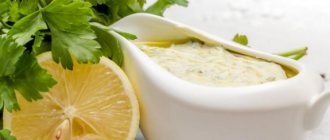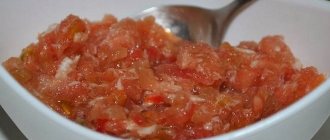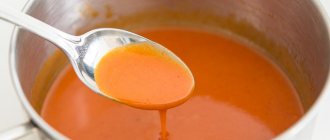Horseradish, horseradish, gorloder, “Ogonyok”, “thistle” - these are all variations on the theme of our popular snack made from horseradish and tomatoes. And although resourceful housewives have adapted spicy ingredients (pepper, garlic) for seasoning, the classic recipe for making horseradish should always be based on real grated horseradish and tomatoes. However, there are many worthy ways that combine horseradish with plums, bell peppers and other additives. Today we will talk about how to prepare horseradish with various ingredients for the winter.
Horseradish with tomatoes and garlic: how to choose products for preparation?
To ensure that the finished product is tasty, healthy, lasts as long as possible and does not spoil, it is important to use high-quality products.
tomatoes that are overripe, but without spoilage. If they are spoiled, the appetizer may ferment before its time. If you take tomatoes with herbs, then both in appearance and in taste the horseradish will be inferior to that made from juicy, dense and ripe fruits. The redder the tomatoes, the brighter the product, the sweeter they are, the more pronounced the taste. The less watery the tomatoes are, the more concentrated the sauce will be. Autumn varieties of tomatoes work great in this recipe; they are suitable both for the preparation time of the horseradish and for their density. These are varieties like Slivka, which ripen to commercial ripeness at the end of August.
Horseradish: you definitely can’t spoil horseradish for them. However, if you take limp, thin roots, you will have a hard time peeling and chopping them. Find strong, thick, juicy roots, peel them and, to be sure, put them in the freezer for a while. As soon as they harden a little, take them out and grind them in a meat grinder, this will make the process go much faster. To avoid crying over the meat grinder, place a plastic bag over the outlet near the grate and collect the grated horseradish in it.
Garlic: the larger the heads, the juicier the vegetable. But the smaller they are, the “angrier” the garlic.
Salt: it should only be coarsely ground. In principle, there should not be any iodized or finely ground salt in preparations, including horseradish!
Cooking tips
- Horseradish roots must be of the highest quality. Preference should be given to the latest harvest. In this case, the taste will be as rich and strong as possible. In addition, the snack prepared at the end of autumn lasts the longest and is stored.
- One of the nuances of preparation is properly preserved root. The taste and beneficial properties will be preserved for three weeks. In this case, it is preferable to dig it out before preparing horseradish.
- To prevent horseradish from irritating the mucous membranes of your eyes when cooking, you should cover the meat grinder with a scarf or plastic bag. If possible, prepare food outdoors.
- You can add different products to the main recipe. To add a special sourness, an apple or gooseberry can be suitable; different types of peppers well diversify the taste sensations. A variety of greens will make the horseradish sauce a particularly rich sauce.
- If you prepare a snack from a dried root, then it is recommended to prepare it correctly: peel, cut, dry in the oven, grind in a coffee grinder. Place in glass jars and store.
This interesting sauce will appeal to every lover of spicy snacks. Horseradish is delicious at any time of the year. It can be easily prepared both seasonally and as a preparation for a long time.
Classic recipe for horseradish for the winter
This recipe combines three things - tomatoes, horseradish root and garlic. Horseradish with tomatoes and garlic is the most common recipe, and many people make it without adding salt. The result is a spicy, spicy sauce or appetizer - whoever you want to call it. A distinctive feature of classic horseradish is that it should only be raw. Real Siberian horseradish was never boiled or pasteurized, it was simply stored in a cold cellar. Today, if there is no cellar, this sauce can be kept in the refrigerator, in a jar with a nylon lid. If everything is done cleanly, carefully, and the correct ratio of salt and garlic is used, the product will not sour or disappear.
Classic recipe for making horseradish: tasty and fast
To prepare horseradish from tomatoes you will need:
- Tomatoes (ripe) – 4 kg
- Horseradish – 200-300 g
- Garlic – 10-20 cloves
- Vegetable oil – 1 cup
- Salt - to taste
How to make homemade horseradish:
Horseradish can be made either from pure tomato juice or from grated tomatoes or minced through a meat grinder. Here the tomato will contain grains. Wash the tomatoes and cut off the stem. Cut into pieces.
Grate the tomatoes and pour the resulting juice into a large saucepan.
Also mince the horseradish root here.
Also grind the garlic through a meat grinder or grate it.
Connect all components. Mix.
Add salt to taste and pour in vegetable oil.
The horseradish is ready, but for a brighter taste it needs to sit in the refrigerator for 1-2 days. The next day you can eat it.
Pour the horseradish into sterile jars.
Usually they don’t have enough patience, and they eat horseradish right away with a large spoon, placing it on a large piece of bread. Good crap goes into your nose and illnesses (if any) disappear on their own. Prepare horseradish for the whole family, teach your children to eat it and increase their immunity.
Bon appetit!
With tomatoes and garlic
So, this is how horseradish is made - the recipe is classic.
Product consumption:
- tomatoes - 2 kg;
- peeled garlic - about a dozen large cloves;
- horseradish roots - 400 g;
- salt to taste.
Then everything is simple: take a meat grinder, grind the horseradish root, then the tomatoes separately, then the garlic. We recommend rolling the tomatoes into a separate bowl so that you can drain off the excess juice - then the horseradish will be thicker and tastier.
This is interesting: horseradish with honey - benefits and contraindications, recipe
Mix everything and add salt to taste. Place the mixture in the refrigerator for half an hour while you sterilize the jars.
The jars must be clean and dry - the latter is also important! While you are preparing the jars, taste the horseradish. Maybe too spicy or under-salted? Add salt or tomatoes.
To prevent mold from inadvertently settling under the lid, you can provide some tricks. Sprinkle a spoonful of boiled vegetable oil on top. You can also lightly coat the lid of the jar with mustard before closing.
Cooking process:
Horseradish roots need to be thoroughly washed and then peeled. Also peel the garlic and cut each tomato into 4 parts. Start twisting the horseradish through the meat grinder, and to prevent the caustic fumes from irritating the mucous membranes of the eyes, you can use a little trick - put a plastic bag on the meat grinder and secure it with an elastic band. After the horseradish, twist the tomatoes and garlic. In a large bowl, combine tomatoes, garlic and horseradish, add sugar, salt, mix well. Place horseradish into prepared jars and pour a small amount of vegetable oil on top of each jar to form a film of 2-3 mm. You can screw the jars with regular screw caps or nylon caps. Such a freezer is stored in the refrigerator throughout the winter.
Other horseradish recipes
There are several other ways to prepare horseradish and they differ not only in proportions, but also in the list of ingredients. You can try this recipe:
for 1 kg of tomatoes, take 300 g of garlic and horseradish, 1 tbsp. salt and sugar, ½ tsp. vinegar 9%. All ingredients are crushed and mixed.
Horseradish with aspirin
If you want a 100% fresh tasting sauce, try horseradish with aspirin. Opponents of acetylsalicylic acid will be horrified at this moment, although the harm from aspirin is attributed only to canned food with heat treatment, and the harm has not yet been proven very well. In this case, the workpiece will be completely raw.
Everything is done in the same way as in the previous recipe, only an additional antiseptic is added to the finished mixture - aspirin tablets in the amount of 1 tablet per 1 liter of horseradish. The tablet should be crushed and mixed with other ingredients. Pour into dry jars and close with strong nylon lids or roll up with metal ones.
Apple tree Tatyana: description of the variety and characteristics, features of planting and care, photo
At the present stage, there are already many varieties of apple trees. These varieties are created by breeders in special institutes of genetics and selection.
Varieties are created for special growing conditions. The required apple sizes, specific taste, and desired color are specially created.
At the same time, breeders create for trees high winter hardiness and the necessary resistance to disease.
Choosing an apple tree variety is not an easy task.
Each person chooses an apple tree according to his own taste. Some people value high winter hardiness and disease resistance. For others, high yields and tasty fruits are important. For others, the size of the tree and compact crown are important.
Recently, columnar and dwarf varieties have become widespread. Due to the small size of trees, maintenance and costs are reduced. Therefore, the choice of variety is everyone’s business.
Belongs to one of the newest varieties. The apple tree was received in Yekaterinburg. This variety has an autumn ripening period. Has a tall tree size. Growth vigor is good. Winter hardiness at a high level.
The fruits are quite large in size. Their weight varies from 100 to 110 grams. The surface of the apples is leveled. The shape of the fruit is regular, flat and round. The main color of apples is white. The top coat is a bright cherry color. This creates a streaky red blush.
The fruit has a very good tasting rating. The apples are very tasty and juicy. The pulp of the apples is white and has a delicate consistency.
Apples ripen closer to the first ten days of September. The shelf life of the fruit is quite long. If stored properly, apples can last up to five months. This is one of the advantages of this variety.
Given the fairly large varietal diversity of apples, the bulk of breeding work is aimed at consolidating the characteristics that make the species resistant to environmental conditions, as well as productivity indicators. A striking example of such activity is the Tatyana variety, which will be discussed in this article.
The variety is quite new and comes from Yekaterinburg. Depending on the place of growth, apple trees of the Sverdlovsk and Ural selection were bred. In the first case, work was carried out to consolidate the trait of scab resistance, in the second - frost resistance.
The plant is tall and reaches a height of about 5 m. Over the course of a year, the shoots lengthen by 45–60 cm. The crown is spreading, the branches are covered with green foliage curved along the longitudinal vein.
The fruits are large, on average 100–110 g. They are round and regular in shape, colored white, combined with a cherry-colored outer shade that forms stripes on the surface. Covered with a smooth glossy peel. The pulp is light, has a delicate consistency and a pleasant sweet taste.
When choosing a variety, it is first necessary to take into account its productive qualities.
The apple tree has an average degree of sensitivity to pathogens, as well as various types of pests. The danger of infection arises when the plant’s immunity is weakened, which occurs as a result of violations of the rules of agricultural technology. The most common disease is considered to be powdery mildew, a fungal disease that affects all parts of the apple tree.
The main symptom is the presence of a white coating on the foliage and branches. Over time, their surface darkens, curls and stops growing. To treat the disease, the tree is sprayed with Brodsky liquid of 3% concentration, at the rate of 10 liters per adult plant and 2 liters for young seedlings.
The variety is resistant to long and severe frosts, and also easily tolerates sudden temperature changes in early spring. It also easily tolerates drought conditions and requires rare but abundant watering.
An autumn variety, it blooms from late April to early May, and fruit ripeness occurs in mid-September. Maturation is uniform.
The first harvest is harvested in the 3rd–4th year of apple tree growth, after which the process of fruit set is repeated annually. Productivity becomes variable with age, i.e. high rates alternate with low ones. From one tree you can collect from 90 to 150 kg of fruit.
Transportability
The peel of apples is quite dense, which significantly affects their commercial quality - the fruits tolerate transportation well.
Growing conditions
The Tatyana apple tree loves sunlight very much, so the variety is grown in well-lit places, and it is important to protect the plant from drafts.
Light loamy soils are ideal, but if the soil is clayey, it must be mixed with sand in a 2:1 ratio. If the soil is sandy, add peat and humus in an amount of 2:1:1.
Seedlings are planted both in the fall, before the onset of frost, and in the spring, until the buds open. The tree is quite large, so it is necessary to calculate the area standards in advance. So, a plot of 4x4 m in size is allocated for one seedling. A hole 70 cm deep and about 1 m in diameter is dug under each tree.
The bottom of the recess is sprinkled with drainage, it can be a small stone, nut shell, etc. After which the fertile mixture is added.
To do this, mix:
- 3 parts humus;
- 1 part superphosphate;
- 0.5 parts potassium chloride.
Then they cover it with a layer of previously dug soil so that the rhizome does not come into contact with the active substances of the fertilizer. A stake is driven into the center of the hole, and a seedling is placed next to it. Straighten its roots and cover it with earth.
Features of care
Then they are grown according to the agricultural technology of this variety.
Soil care
Water the apple tree at least 4 times per season, depending on climatic conditions. Before watering, you need to form a depression around the trunk at a distance of 50 cm, this will prevent the liquid from spreading over the area. About 3-4 buckets of water are allocated for one young tree, for adult plants - 6-8.
After each procedure, it is necessary to loosen the soil around the tree trunk, while simultaneously removing weeds. Then sprinkle with mulch: sawdust, fine peat, humus.
Fertilizers
In order for the tree to grow actively and produce rich harvests, it is important not to forget about regular feeding. Active ingredients are added for the first time during the season in mid-April.
During this period, it is important to stimulate the growth of the apple tree; for this purpose, nitrogen-containing substances are used, per 1 tree:
- 500 g urea;
- 30 g ammonium nitrate;
- 30 g nitroammophoska;
- 5 buckets of humus.
All of the above components are added for digging.
During flowering, use an aqueous solution of the following components, per 10 liters required:
- 100 g superphosphate;
- 60 g potassium sulfate;
- 2 liters of chicken droppings;
- 1/2 bucket of manure;
- 300 g urea.
On average, 4 buckets of solution are needed per tree. After the apple tree has finished blooming, you need to apply 30 liters of fertilizer, which includes:
- 500 g nitrophoska;
- 10 g of dry sodium humate;
- 100 liters of water.
Every spring the crown is pruned; this activity is carried out before the beginning of the growing season, but under conditions of stable above-zero temperatures. First of all, old and dried shoots are removed. Then, according to the sparse-tiered scheme, branches growing at an acute angle relative to the trunk. Basic principles of apple tree pruning
Preparing for winter
As mentioned above, the variety is resistant to frost, but this does not negate a number of works aimed at preparing for wintering. Using a metal brush, carefully clean the trunk and main branches of dead bark and lichens. Then form a soil embankment about 40 cm high at the base of the trunk.
Technical ripeness of the fruits occurs in mid-September, since the process is uniform, you can pick all the apples at once. The fruit is removed along with the stalk and placed in layers in a well-ventilated container.
It is important to place the fruits so that the cuttings do not damage the integrity of the remaining apples; to do this, they are covered with paper. The optimal temperature for storage is considered to be 5°C. In such conditions, apples will last about 5 months. Every year, breeding scientists develop new varieties of apples, endowed with a number of advantages. Mainly - resistance to weather conditions and pathogenic microorganisms, while not being inferior to others in terms of productivity.
A striking example of such achievements can be considered apples of the Tatyana variety, the cultivation features of which are discussed in detail above.
Breeders are developing new varieties that meet certain requirements: the required size of fruits, their color, taste characteristics, ability to withstand frost, and withstand heat. Climatic conditions play a decisive role when choosing an apple tree variety for planting.
The Tatyana apple tree variety was recently bred in Yekaterinburg; its description and photo, recommendations for care and planting are presented below.
The Tatyana apple tree variety was recently bred in Yekaterinburg; its description and photo, recommendations for care and planting are presented below.
Horseradish for the winter without cooking, pickled
There is another interesting and unexpected way of preparing natural horseradish. Its beauty is that it contains only tomatoes, garlic, salt and horseradish, and no chemical preservatives in the form of vinegar. However, this method allows you to store the seasoning even outside the refrigerator, because it cannot sour - the principle of fermentation is the basis for its preparation. This seasoning has a sharper and sour taste because it contains a fair amount of lactic acid formed during the fermentation process. Sour, spicy, harsh in taste, it is especially good with meat, for which men usually love it.
To prepare fermented horseradish, we will need:
- a bucket of ripe tomatoes (if you need a smaller amount of the finished product, reduce everything proportionally to the required volume);
- a kilo or half a kilo of peeled garlic (the more garlic, the spicier the sauce);
- horseradish roots - 400 g;
- hot pepper - 3-5 pods;
- salt - to taste.
Grind the tomatoes through a meat grinder, pass seedless peppers, horseradish, and garlic through it. Add salt until it tastes good. Mix everything and pour into a 12-liter bucket. It is important that there is a little space left from the edges of the bucket to the dish in question - the seasoning will begin to “play” and foam.
Cover the bucket and leave at room temperature for five days. During this time, in the warmth, the tomato with horseradish and other ingredients will begin to ferment. First, bubbles and foam will appear on the surface, then gradually the tomato will rise to the top, leaving liquid juice below. Stir occasionally and wait: it should do its part and acquire a sour taste. The seasoning is ready when fermentation stops. This, by the way, can happen earlier or later, depending on the temperature in the room.
Pour the finished product into clean, dry (!) jars, and also pour into plastic bottles. Store under normal conditions, but if it is possible to keep it in the cold, it is better in the refrigerator. This seasoning is usually valued precisely for its pungency and sharpness of taste. It is also sometimes called “pluck your eye out.”
Recipe for preparing horseradish for the winter
Since ancient times, horseradish has been an integral attribute on every table; it symbolizes health, strong family relationships and preserves traditions. In summer, the leaves of the plant can be used to preserve cucumbers, which, thanks to this component, become crispy and do not become soft. And in winter, the beneficial properties of this product can be used to prevent viral diseases.
It is better to stock up on horseradish for the whole next year in the fall, since it is at this time of year that it is juicy and has healing properties. It is best to store the root at low temperatures, in a room with high humidity levels. However, if it is not possible to store the product, then you can prepare horseradish for the winter, in the form of powder or canned food.
One of the alternative preparation options is drying the product. To do this, you need to clean the root from the soil, rinse with running water and dry with paper towels. Grate the finished root on a fine grater (or grind in a meat grinder) and dry in the oven.
Grind the resulting product in a coffee grinder, pour the powder into dry jars and roll up. Subsequently, the mixture can be used as a seasoning for various dishes.
Another popular recipe is to make horseradish relish with vinegar. To prepare it you need:
- 500 ml water;
- 40 g salt;
- 80 g sugar;
- 30 ml vinegar.
Bring water to a boil, add salt, sugar, vinegar and let it brew. After a day, mix the marinade from 1 kg of grated horseradish and roll up with metal lids.
What is couscous and how can you prepare delicious dishes from this healthy grain? Minced cod cutlets are tasty, healthy and satisfying. Read and cook with pleasure!
Find out the recipe for how to properly bake lamb ribs in the oven.
Cooking method: boiling
There is a hot way to prepare this popular seasoning. In this case, boiling for 5 minutes will make it suitable for storage in any home environment.
We take:
- 2 kilograms of fresh tomatoes;
- 300 grams of horseradish roots;
- 4 heads of peeled garlic;
- 4 teaspoons salt and 2 teaspoons sugar;
- a couple of pinches of red hot pepper. It's even better to replace it with fresh capsicum. In this case, you will need a small piece of the pod, cleared of seeds.
Cooking method
- Peel the horseradish root, pour boiling water over it (this will remove excessive harshness and bitterness).
- Peel the garlic.
- Remove the stems from the tomatoes and, after pouring boiling water over them, remove the skins. Although you can use unpeeled tomatoes. Cut off places where there are stalks.
- Grate the tomatoes, horseradish and garlic using a large-hole grater. You can also use a meat grinder, which will make the task easier.
- Mix everything together, add salt and sugar.
- Cook for at least 5 minutes, or longer if you want to reduce the liquid and create a thicker consistency.
- Pour hot seasoning into prepared sterilized jars, cover with sterile nylon lids and cool. Store in a cool place. And it is advisable to try it only after a week - during this time the seasoning should reach the desired taste and infuse.
How to cook horseradish at home - recipe
Ingredients
- The horseradish root is 30 centimeters long and 10-11 centimeters in diameter at the thickest part.
- 2-3 teaspoons of sugar.
- 1 tablespoon of vinegar 9% or lemon juice.
- 100-150 ml of cold boiled water.
- 1 teaspoon salt.
Preparation
Wash the horseradish root thoroughly with a brush under running water, then soak it in very cold water for 3-4 days.
We change the water daily. If the horseradish is quite dry, you can soak it for 5-7 days - its quality will only improve and it will be much easier to grate. After the period of floundering in the water has passed, we take out the horseradish,
clean it
and grate it on a grater, not the largest one, like in the photo.
You can, of course, use a blender. But the taste of horseradish after this centrifuge becomes unpleasant. Many years of experience in producing this dish suggests that it is necessary to grate it.
Even if at this moment your native body doesn’t really understand you - your eyes are widening, tears are flowing, like after a Mexican TV series, and it’s taking your breath away, like on a first date. This is more useful than harmful.
So it's worn out! Now fill the tormentor with water in which salt, sugar and vinegar or lemon juice have already been dissolved.
If the horseradish is still dry, add a little more water. That's all! This is the basic workpiece.
My comments
From the basic preparation you can make a bunch of other seasonings: mix to taste with mayonnaise, thick sour cream, mild mustard, ketchup.
Here's some more food for thought. Mix the horseradish preparation with a coarsely grated apple, which must first be stewed and mixed with warm caramel. This is an excellent sauce for oven-baked pork loin with bone.
Try combinations such as horseradish and redcurrant jelly or blackcurrant jam. I want to experiment myself and serve this with some new meat dish.
I offer my sincere gratitude to my esteemed commentators. I look forward to more comments. If you liked the article, please share it on social networks. And so that you don’t miss interesting and useful events on the blog - receive my new articles by email - subscribe to blog updates.
Here is a good video recipe for a delicious horseradish sauce. The video is in English, but minimal knowledge of the language is enough to understand what it’s about:
With the addition of ripe plums
This sauce will be a little reminiscent of the famous Caucasian tkemali sauce, which is also made from plums. In this case, ripe sweet plum is added to the seasoning, which will add its own notes and add a piquant sourness.
For one serving of seasoning you need to prepare 100 grams of grated horseradish and pitted plums, 1 head of garlic, 2 tablespoons of sugar and salt - to taste. The most important ingredient is tomatoes, take 1 kg of them.
Grind all ingredients through a meat grinder, including plums, add sugar and salt. Place in jars, close with clean lids, and store in the refrigerator.
Horseradish with beets
Why resort to store-bought ingredients when you can prepare everything yourself in advance? The taste of the dish will only benefit from this, and the result will exceed any expectations. Horseradish, with fresh beets, will be a worthy sauce for any meat dish. It will not only highlight any products, but also give them a special piquancy and richness.
Ingredients:
- Svela - one medium root vegetable.
- Horseradish root – 350 grams.
- Table vinegar – 10 milligrams.
- Filtered water – 1/2 cup.
- Salt – 10 grams.
- Sugar – 10 grams.
Yield: 700 grams.
Cooking process:
1. Peel the horseradish root. Grind using a meat grinder.
2. Peel the root vegetable and divide into pieces. Pass through a meat grinder or grate on a fine grater.
3. Combine all products and mix thoroughly.
4.If the beets are not juicy, then you can add another 50 milligrams of water to obtain the required consistency.
5. Sterilize the jars. Dry. Pour the sauce and cover with a lid.
You can store the snack in the refrigerator for 4-5 months. During this time, its taste will be enriched with new notes.
Horseradish with apples for the winter
First, about how to prepare apple cider for winter storage. You will need vinegar here.
Cut four apples into four parts, remove seeds and boil in a small amount of water until soft. You can cook them in a slow cooker or, even better, bake them in the oven. After this, rub the apples through a fine colander or sieve. You should get a soft puree without peel. Next, grate or chop the horseradish root and add it to the applesauce. Salt everything, add a little sugar, put it on the fire and, stirring constantly so that it does not stick to the bottom and walls, boil for about five minutes at a low boil. Before finishing, add a drop of vinegar. The taste should be sweet-sour, piquant. Place the finished snack in sterile jars and roll up. This is an aromatic seasoning that has a pungent taste. Therefore, it is better to do the layout in small jars, so that it is enough for once or twice.
If you need a quick seasoning for the table, not for winter, then you can make another very interesting appetizer of apples with horseradish and lemon.
For her, horseradish (1 root), green apples (4 pcs.), celery greens (small bunch), garlic (several cloves), half a lemon with peel and without seeds, put through a meat grinder, mix everything. No need to salt!
Classic homemade horseradish recipe
- Peel the prepared horseradish, chop it by passing it through a meat grinder. Use a nozzle that allows you to get the most fine and delicate consistency, similar to puree. Don't forget to attach a bag to it to at least partially protect your eyes from the pungent odor.
- Mix chopped horseradish root with salt and sugar.
- Boil water and pour boiling water over the horseradish, stir.
- Sterilize very small jars and place the seasoning in them. Pour a little lemon juice into each jar: no more than a teaspoon per 0.2 liter jar, but not less than two milliliters. The juice will act as a preservative and at the same time prevent the horseradish from darkening. However, you don’t need a lot of juice to prevent the seasoning from turning out sour—according to the traditional recipe, it shouldn’t be.
- Close the jars tightly and place in the refrigerator.
Horseradish prepared at home according to the classic recipe can be stored for no more than 4 months, but it is still better not to risk it and eat it a month or two before. If you plan to store the product all winter, it is better to choose a different recipe, with vinegar.
Cooking with beets
You can add a little boiled beets to horseradish prepared in the usual way - this will add additional flavor to the appetizer and the color will become more saturated. However, due to the bright color of this vegetable, beets are often used in sauces prepared without tomatoes at all. If you want to prepare such horseradish, grate or grind horseradish in a meat grinder, boil sweet and dark burgundy beets. Grate it on a fine grater and squeeze out the juice, add it to the horseradish, add salt to taste and add a little sugar. Finally, you need to dilute the seasoning with vinegar to your taste. If the mixture is too thick, add boiled cold water. The seasoning is stored in the refrigerator, but it will not last all winter.
Growing on various rootstocks
- Breeders of the city of Sverdlovsk zoned the variety to the conditions of their region. The variety has received high resistance to scab and average resistance to other diseases.
- The Ural selection variety can withstand long winter frosts and does not suffer from frost damage. In addition, it is able to withstand sudden temperature changes in the spring and winter.
Columnar trees, successfully grown in the conditions of the Urals and Altai Territory, have gained particular popularity.
A columnar seedling of this variety, according to gardeners, has many advantages. Convenience of harvesting and reduced costs of caring for apple trees are the main advantages of columnar trees.
Cooking without tomatoes
Among the unusual cooking recipes, there are many interesting seasoning options without tomatoes. Try making a small batch with rye bread! This is an old recipe that our ancestors knew. It is tasty, although this seasoning is not suitable for winter storage.
Required:
- horseradish roots;
- liquid honey (it should be taken at the rate of 150 g per kilo of finished snack);
- Rye bread;
- white radish;
- ground cloves - a pinch, can be replaced with dried mint;
- vinegar and salt to taste.
Cut off the crust from dark bread and brown it in the oven or in a dry frying pan. We clean the radish and grind it through a meat grinder. Juice will be released from it - drain it by squeezing the radish. Also turn the crust of the bread.
Peel the horseradish, grind it, add everything previously chopped, not forgetting to add salt and pour in a little vinegar. Everything is done by eye, by inspiration. At this stage you should have a thick sauce, to which you add spices and honey. Mix everything again. The seasoning is ready - vigorous, aromatic, with an unusual and pleasant bready taste and aroma of spices.
Recipe with mustard
With mustard, horseradish acquires an extraordinary pungency and pungency, so we advise you to scald the horseradish a little and cool before cooking.
Next we do this:
- Make a tomato from two kilograms of tomatoes and boil it over low heat for half an hour.
- Pour half a teaspoon (teaspoon) of store-bought mustard powder and a couple of cloves into the tomato. Add spices with ground red and black pepper (a quarter spoon each).
- Take 50 g of ready-made grated horseradish, a tablespoon of salt, 150 grams of granulated sugar, put everything in a tomato and boil for another ten minutes. Before the end of cooking, pour in 1 tbsp. a spoonful of table vinegar.
- Pour into sterilized jars and roll up.
This product is stored under normal conditions.
Is it possible to cook horseradish without tomatoes?
Since not everyone likes tomatoes, on culinary forums housewives often discuss variations of the seasoning in its pure form, that is, from garlic and horseradish.
It is only at first glance that it seems impossible to voluntarily eat such a spicy mixture.
In fact, there are many delicious recipes for homemade horseradish without tomatoes. Let's consider the classic version.
You can prepare various preparations from tomatoes: tomatoes with carrot tops, tomatoes in jelly, pickle, make sun-dried tomatoes, tomato juice, prepare a salad with cucumbers, prepare tomatoes in their own juice or make jam from green tomatoes.
What you will need
For cooking we will need the following products:
- fresh horseradish root - 1 kg;
- fresh beets - 0.5 kg;
- sugar - 100 g;
- salt - 1 tablespoon;
- table vinegar (9%) - 200 ml.
From kitchen utensils, collect:
- cutting board;
- kitchen knife;
- blender;
- deep container;
- large bowl;
- tablespoon;
- paper towels;
- 2 washed and sterilized liter jars with lids;
- cloth towel;
- plate.
Did you know? Oncologist V. Laskin believes that horseradish root can save a person from lung cancer. In his opinion, for preventive purposes, it is enough to inhale the evaporation of the crushed product for 3 minutes every day.











